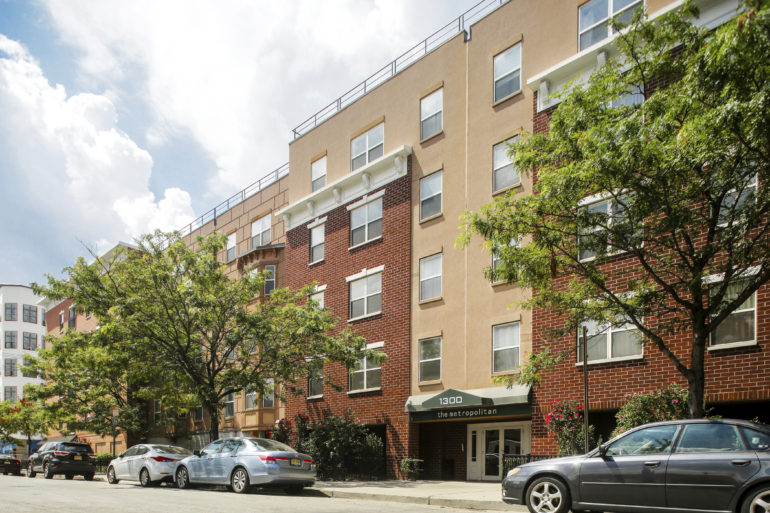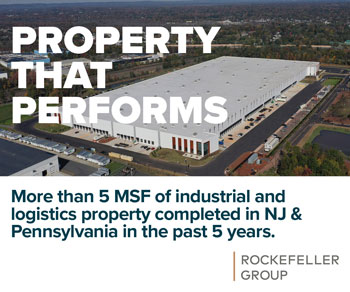The Metropolitan, located at 1300 Clinton St. and 1313 Grand St in Hoboken – Courtesy: HFF
By Joshua Burd
Call it a tale of two markets when it comes to New Jersey’s apartment sector.
In this case, both markets happen to be doing quite well.
That was among several themes to emerge last week as a panel of industry experts touted the success of two separate classes in the state’s multifamily sector. One set consists of the high-end, newly built rentals along the Hudson waterfront, while the other includes the older, garden-style apartments that are farther west, but ripe for value-add improvements.
Both groups have been standouts during a cycle in which the state’s rental market has seen unprecedented growth and interest from investors. The appetite for both continues to be strong.
“There’s money and capital set up specifically to buy Class A deals, so that’s a pretty steady demand,” said Jose Cruz, a senior managing director with HFF. “Class B, which does ebb and flow, today and for the last several years continues to be on everybody’s wish list.”
Opportunities with older properties often involve renovating leased or partially leased portfolios and raising rents, Cruz said. Returns are typically in the high teens or 20 percent, he said, making it an attractive proposition for an increasing pool of buyers.
He spoke Thursday during the New Jersey Apartment Summit, an event that drew hundreds of investors, developers and industry leaders to the Westminster Hotel in Livingston. Panelists highlighted two distinct asset classes within the state’s apartment stock — noting that, while they may be at different points in the cycle, both still have bright prospects in the near term.
When it comes to the Gold Coast, new construction continues to offer a discount to rents in Manhattan. But Noah Chrismer, director of planning for KRE Group, said the market has evolved in places like Hoboken and Jersey City — leading developers to build in previously overlooked neighborhoods such as Journal Square, which still provide the all-important access to Lower Manhattan but now offer their own lifestyle.
“That, for us, is more of a driver, and those key assets around good, transit-oriented locations are more driven by their own fundamentals now, we believe, than they are as a discount to Manhattan and Brooklyn,” he said. “So we’ve begun to shift our thinking toward Jersey City and the Gold Coast as a place that people want to locate, versus a place that people have to locate because they can’t be in Manhattan.”

Panelists said that some of those same fundamentals translate to the suburbs beyond Hudson County. Adam Altman, managing member of KABR Group, said that’s evident by the fact that the New York metropolitan area “is one of the few markets” in which institutional investors are willing to consider Class B properties.
“Once you leave this geography, most institutions will not enter into that (class),” Altman said, later adding: “It’s only this New York area — because it’s so valuable — that they’re willing to partake in that, whether it’s in New Jersey or Brooklyn or wherever else.”
Class B investors who look farther west of Manhattan also see the appeal of in-place yield and less competition from new development, the panel said. Arthur Rosenberg Azure Partners LLC pointed to his firm’s acquisition last year of The Crest at Princeton Meadows, a 704-unit rental property in Plainsboro that was built 30 years ago, but is the newest community in the township.
The area also boasts a strong business and educational infrastructure, he said.
“We view that as a place that you may not get 8 or 10 percent annual rent growth in certain very, very high-growth years, like you may on the Gold Coast,” said Rosenberg, co-founder and CEO of the New York-based investment firm. “But you’re going to see a very, very steady 2 and a half to 5 percent — depending on where you are in the cycle — with high barriers to entry and no supply coming. So we prefer to invest in those types of locations.”
Cruz added that “Class B and C definitely are the flavor of the day” among investors, and the owners among the panelists said that has translated into more competition.
“We continue to be stronger in New Jersey than in Pennsylvania, but things keep moving west, such that the marketplace in Pennsylvania has become competitive,” said Alan Hammer, an attorney with Brach Eichler and longtime multifamily owner.
The increased interest has also made the value-add market, “extremely crowded right now,” Rosenberg said. He noted that the spreads between Class A investments and value-add Class B projects have “narrowed significantly because there’s just a gigantic amount of capital looking to come to the value-add space.”
Azure Partners has responded by trying to find Class A opportunities with lease-up risk, he said, such as a project that is 50 percent occupied and whose developer has run into trouble.
For other panelists, there is no straying from the value-add formula. Eric Margules, founder of Margules Properties, explained why.
“(The) great thing about value-add is you can sleep at night,” he said. “We don’t really care that much about interest rates because we just care about revenue raising, and it’s not about our expenses nearly as much as just getting in there, getting the vacancy, renovating it and raising the rent.
“That kind of thing can weather any kind of environment. … In value-add, we’re fine and we’ll continue. We’ve just got to find the product.”










